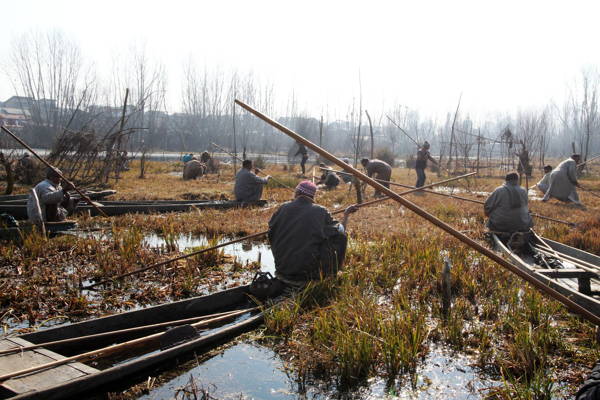I have declared the Anchar Lake as ‘dead’, says noted environmentalist Abdul Majeed Kak.
There are no more fish in the lake, they have died because of bio-medical waste from SKIMS allege locals.
Srinagar: Every day, Farooq Ahmed Malla has to walk along the banks of Lake Anchar, which is on the way to a grocery shop he now owns. Every day, he feels a terrible stench engulfing the whole region.
Walking past, he puts a handkerchief to cover his nose to save himself from the unbearable smell emanating from the lake.
Malla is a forty-year old man who once earned good money, harvesting different resources that the lake had to offer. He would grow a variety of vegetables, had a chunk in the fish production, and would sell them at a good price. The lake would remain his only source of livelihood.
But now he laments and worries about the deterring condition of the lake which has turned poisonous with all the waste dumped into it.
“I still remember my place. Whenever I used to walk on the banks of the lake, it used to be lush, covered with leafy vegetables and serene ambiance, but now every poisonous water drop that flows directly into the lake makes me numb inside. These days, it’s hard for anyone to tolerate the smell,” he said getting nostalgic.
Anchar, which once remained his source of earning, haunts him whenever he looks at it.
Now, Malla is running a grocery shop in the vicinity of the Sher-e-Kashmir Institute of Medical Sciences (SKIMS) institute. He has been running the shop after the lake started turning toxic and poisonous. His only source of livelihood would no longer cater to his needs like it used to.
He once used to depend on the agriculture within the Lake. The vegetables he would cultivate (like the Lotus Root, popularly known as Nadur in Kashmir) would be enough to meet the ends. The fish harvest was more than enough to pay the bills.
He has made a rough drawing that shows the complete route of the liquid biomedical waste discharge from SKIMS into the lake.

He is a resident of Buhlachpora area of Soura, some 15 kilometres away from the heart of the city. His house is situated behind the famous SKIMS institute, on the banks of Anchar Lake. The area comprises of about a thousand households, spreading around 3 kilometres.
Farooq carries multiple official records that read, “The encroachment of SKIMS institute has contributed in the chemical and biomedical sewerage flow to the Anchar Lake which has adversely shattered his livelihood.”
“I have approached various officials including the Deputy Commissioner Srinagar, the estate officer, SKIMS, even the Chief Minister, but nothing has happened so far. Everyone among them admits that it is SKIMS that is responsible for the degradation of the lake but no stern action has been taken so far. I am yet to receive a proper compensation,” he says.
He claims that he has around ten acres of land which is rendered useless now.
“Despite various visits to government and administrative officials, the government has not rehabilitated and compensated us with what we deserve and what was promised to us,” he said expressing his concerns.

According to the residents who live nearby, it is a miserable life during the summers when the lake stinks terribly due to the heat.
It is hard for them to open their windows during the summer. They can’t breathe fresh air, nor sleep at night as houseflies and bugs make their way right into their homes.
“We spend most of our nights in sleeplessness,” said Hajira Bano, a female resident of the same locality.
“Take a look at the lake and tell me what you see. There is barely any part of the lake left”, says Fayaz Ahmad while pointing towards the channel that allows the chemical liquid into the lake.
According to a report by the Kashmir observer, “The encroachment, pollution and illegal constructions within its vicinity have brought the lake to the point of extinction. One of the major factors which have wreaked havoc with the Anchar’s ecosystem is the heavy flow of effluents from SKIMS. But while the government has taken measures to rescue Dal and Nigeen, there have been fewer initiatives to conserve Anchar. It will be only a matter of time before Anchar is converted into a filthy patch of land mass. The lake deserves an ambitious conservation plan on the same pattern as Dal and Nigeen.”

Professor MRD Kundargarh, a noted environmentalist, says that wetlands are a great blessing of nature which we all must strive to protect.
Kundagarh has written a detailed report on threatened wetlands in Kashmir, “Anchar Lake is situated at a distance of fourteen kilometres to the northwest of Srinagar at an altitude of 1584m. It is a single-basin lake connected on the eastern side with the Dal Lake through an inflow channel ‘Nallah Amir Khan’ via Gilasr and Khushalsar. A network of channels from the cold water Nallah Sindh enters the lake on its western shore forming a delta,” he informs.
“Besides this, unabated encroachments are still continuing at an alarming rate. The rate of encroachment in the Anchar Lake till the year 2000 has been estimated at 0.184 km per year”, Kundangarh informed FreePressKashmir.
According to Walter R. Lawrence, the area of the lake Anchar in 1893-1894 was 19.54 square kilometres. It has now been reduced to 6.8 square kilometres of which 3.6 square kilometres are marshy.
Lawrence, a British author and an Indian civil servant wrote many travelogues. His book ‘The Valley of Kashmir’ is regarded as a reference when it comes to matters regarding the valley.
Populations of aquatic birds, both resident and migratory have also been affected and subsequently their food supplies are reduced.
Marshes within the lake are being mainly used for the cultivation of Salix sp. (Willow) used for the fabrication of wooden baskets and furniture, and most of the lake area has been brought under willow plantation reducing the open water surface at an alarming rate.

Dr. Abdul Majeed Kak, a noted environmentalist and research coordinator in Islamic university of science and technology, while talking to FreePressKashmir said, “I have clearly declared the lake Anchar as dead. Besides SKIMS institute, the residents around the lake are also responsible for the mess that the lake is in,” he says.
Discharge of untreated effluents, sewage from surrounding human settlements is directly pouring into the lake. Putrefied domestic animals are seen floating in its waters, making the lake water extremely polluted and filthy. The fauna and flora, excellently thriving few decades ago, are now replaced by eutrophic weeds. Many of the medicinal and nutritional plants of the lake are either totally extinct or nearing extinction.
Kak, with a sense of nostalgia, says,“The Anchar Lake was neat and clean with its crystal clear water used for drinking purposes, as well as for other domestic purposes. Visitors used to take a boat ride from Dal Lake to the Khushal Sar Lake and used to stroll all around this lake.”
A few years ago, environmentalists raised a cry about the liquid and solid biomedical wastes of SKIMS which is directly poured in lake. Some measures were taken by the authorities of the Institute on the behest of Pollution Control Board, and two furnaces were installed in 2008 for the disposal of solid wastes.
However, only one is functional and is not sufficient to cater to the disposal of all solid wastes. But disposal of liquid wastes is still a problem as there is no proper system for it.
Locals and some environmentalists have raised concern about the present deterring condition of the lake that has drastically affected the aquatic life living inside it.
“A decade ago, we would catch a good amount of fish in the lake. On an average, we would catch about 10-20 fish a day. Now we can’t catch even one”, says a local resident Hussain Khurshid.
This reporter hired a boat and went into the lake and found some women in the midst, removing weeds out of the lake for domestic animals back home. They come early in the morning and collect good amount of grass for their cattle.
Haneefa, while raising both her hands up to her ears said, “To save ourselves from serious infection and skin rashes, we have to apply ointments on our whole body before entering the lake. It is known as Kilum in Kashmiri. It is not safe to enter without it. Accidentally, if your leg dips in the water, you get quick allergies and rashes.”
At the same time, they unanimously say that if the government has occupied huge water space for their purpose, they (government) should take some positive steps to save the lake and make it more beautiful.
“Government is not concerned about this lake. They should beautify it and not use it for biomedical liquid waste, which eventually damages the ecosystem”, said Bashir Ahmad, an engineer by profession.
According to the locals more than 500 acres of water space in the lake is under government use.
“Their treatment plant is a failure. If you look at the condition of the Sewage Treatment Plant (STP) there, you will know that it is not working at all,” says a local who wished anonymity.
While moving within the vicinity of the institute, we found a Sewerage and treatment plant. We entered and verified the condition of the STP plant.
While talking to the in-charge, STP SKIMS, he said “Our STP is working properly. We use a variety of chemicals like Lime, Alum, Salt, and Bleaching powder to filter and purify the water that comes directly from the hospital,” he says.

When asked why the Lake is being used for discharging of bio medical waste, he said “We have 6 reserved tube wells in the STP. When water, after getting filtered, runs in those reserved tube wells only after that, it overflows into the lake. We are helpless in that case.”
However, he was quick to add, “But that water is filtered.”
He says that every month the pollution control board with the assistance of LAWDA tests the water quality.
Dr. Syed Nadeem Hussain, regional director Kashmir, pollution control board, while talking to FreePressKashmir said “SKIMS has it’s own STP that processes and filters the water quality. We keep monitoring their process and take samples from time to time.”
He further added that they get unpredictable results at times, and when there is a doubt, they issue a notice.
Hussain believes that locals of the area are also responsible for the mess of Lake Anchar.
“You can see that the locals throw garbage directly into the lake, SKIMS does not contribute much to the pollution of the lake,” he added.
Anchar lake comes under the jurisdiction of Srinagar Municipal Municipal corporation.
Despite repeated calls to the office of Srinagar Municipal Corporation, none could be contacted for a comment.








